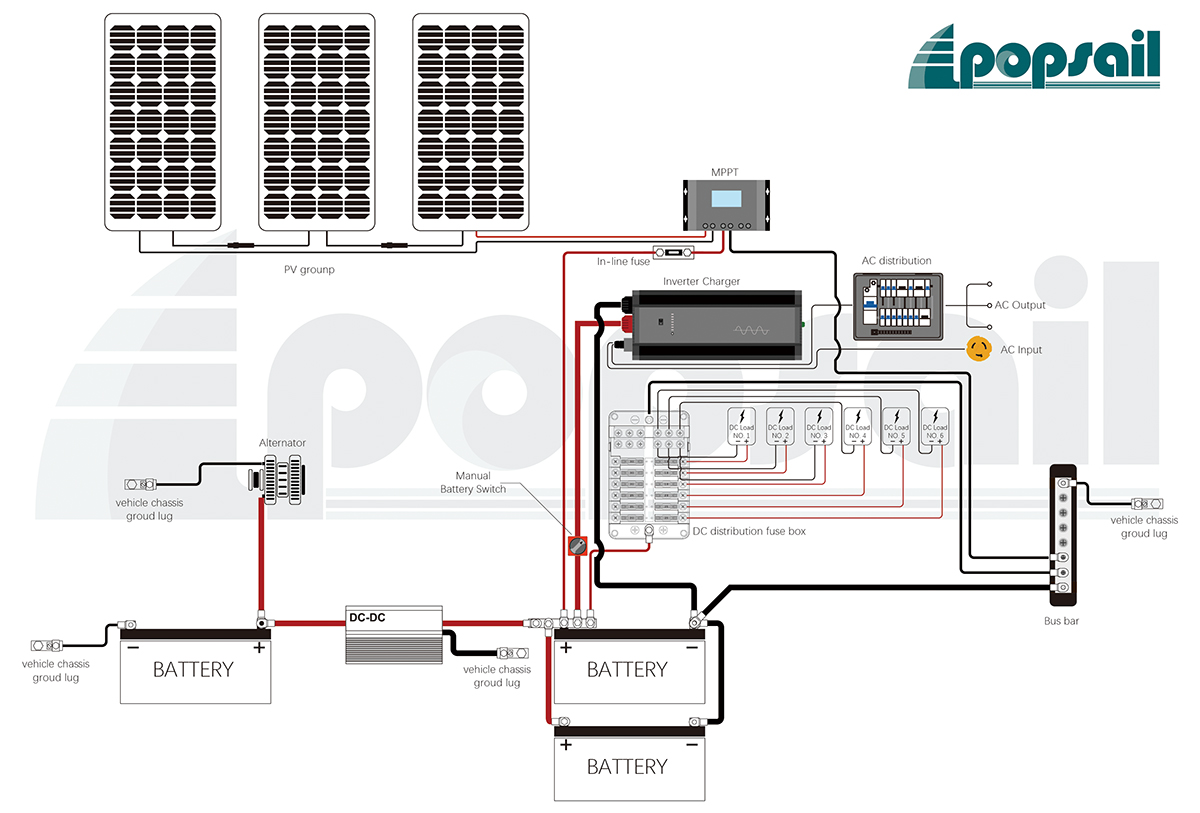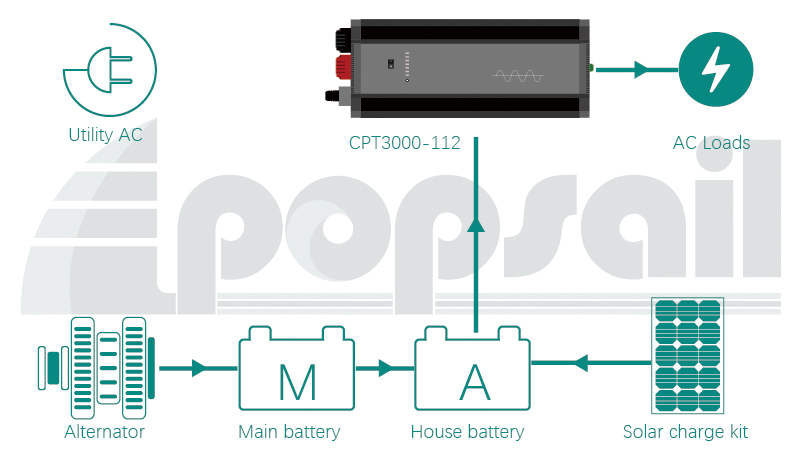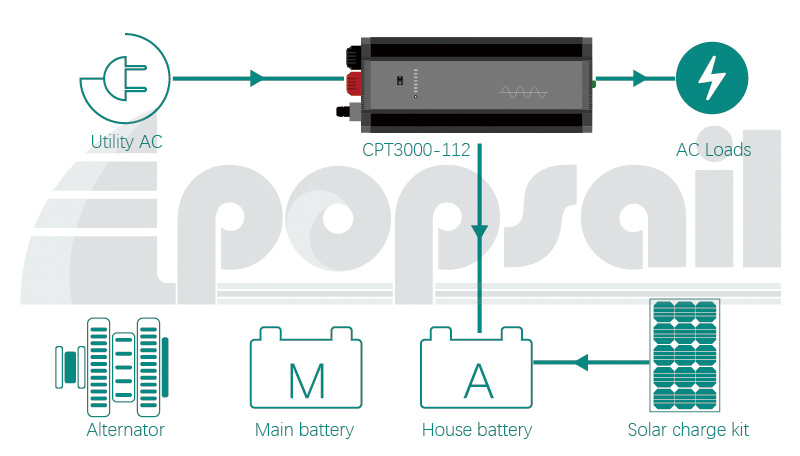This is always a difficulty question for camper van or motorhome DIYer. There are thousand million questions in some Facebook group. But none basic conclusion can be found from too many correct suggetion. Everyone share their own configuration but cannot fit to other people.
Different people expect different cofiguration. Some people is willing to get power as much as possible. But some people only need a small pack battery to run some LED lights and cellphone charger. We try to avoid too much scientific inference, and just tell the best factor or numbers.
After reading this you will be enabled to set up your own RV power system. Let's get it started!
*Popsail put the diagram in advance for your quick view.

One thing we need remember, the most economic configuration is:
Discharged energy = Available battery bank energy = Charged energy
Discharged Energy
We also call it "how much energy your happy camper life will need for Total OFF GRID". Take a paper and grasp a pen, write down the appliance you will use in your lovely camper van in the coming days.
For example:
| Appliance |
Load Type |
Powe r(Watt) |
Qty |
Total Power (Watt) |
Estimated working time/day (hours) |
Total power consumption (Wh) |
| LED light |
DC |
6 | 8 | 48 | 5 | 240 |
|
Kettle |
AC | 1200 | 1 | 1200 | 0.3 | 360 |
| Laptop | AC | 65 | 1 | 65 | 2 | 130 |
| Cellphone charger | AC | 5 | 2 | 10 | 4 | 40 |
| Induction cooker | AC | 1200 | 1 | 1200 | 0.7 | 840 |
| Roof vent | DC | 48 | 1 | 48 | 4 | 192 |
| Blender | AC | 1500 | 1 | 1500 | 0.2 | 300 |
|
Coffee machine |
AC | 900 | 1 | 900 | 0.5 | 450 |
| Microwave | AC | 1100 | 1 | 1100 | 0.2 | 220 |
|
Water pump 1 |
DC | 240 | 1 | 240 | 0.2 | 48 |
| Water pump 2 | DC | 240 | 1 | 240 | 0.2 | 48 |
| Reading Light | DC | 10 | 2 | 20 | 2 | 40 |
| Cabinet Light | DC | 5 | 4 | 20 | 0.2 | 4 |
| Total |
|
|
|
|
|
2912Wh |
The basic total consumption per day can be seen as 2912Wh, but there are also electrical parts like some relays, cables and power inverter will also stand by and they will be fed with the small power. They are also consuming power from battery. Generally adding another 50Wh is very good for camper van.
Now we are getting: 2912Wh+50Wh=2962Wh
This calculating result will be used for sizing your battery bank.
Available Battery Bank Energy
Let's see how to configure the battery.
There are two general battery types: Sealed-Lead-Acid battery, Lithium battery
Sealed lead acid battery available DOD(depth of discharge) is 68%;
Total power consumption(Wh) / 68% = SLA battery capacity
Lithium battery avaiable DOD(depth of discharge) is 85%;
Total power consumption(Wh) / 85% = SLA battery capacity
Therefore we can get:
SLA battery: 2962Wh / 68% = 4356Wh;
4356Wh / 12V(rated battery voltage) = 363Ah
According to this formula the estimated battery bank is 12V 363Ah. But there is impossible to find 12V 363Ah, so we have to use 12V 200Ah battery two pieces in parallel;
Lithium battery: 2962 / 85% = 3485Wh;
3485Wh / 12V = 290Ah
According to this formula the estimated battery is 12V 290Ah. The easy solution can be found is one 12V 300Ah LiFePO4 battery.
*PS. NEVER parallel or series two lithium batteries unless two batteries can be communcated with each other(BMS communicated).
Charged Energy
Charge the battery to be full so that you can enjoy the loads 100% fully functional in your adventure.
There are three ways to charge your battery
1. Alternator - on board charge
2. Battery charger - External utility AC-DC charge
3. Solar charger - MPPT solar charge
Alternator - House battery
Generally the 20/30/40A DC-DC charger will be selected to realize the on-board charging.
For example with 40A DC-DC charger, the charged energy will be:
12V(rated battery voltage) × 40A = 480W. Assmue you will on the going for around 2 hours per day. You can get max. 480W×2h=960Wh energy per day.
Battery charger - External utility AC-DC charge
It looks like the best way to make your house battery(leisure battery) be fully charged with a limited time. If you can reach to a place where offer good utility AC. Use it! But if you have limited time to operate, select an 60A battery charger, easy to buy.
12V(rated battery voltage) × 60A × 2h(estimated possible charge time) = 1440W.
You can find 2 hours is not enough for fully charging. If there is no solar charge as backup, charge the battery by AC for a longer time as possible as you can.
Solar charger - Charge battery anytime with Sunlight
The camper like Sprinter, its roof allows max. 4pcs 125W solar panel. (remember measuring your camper roof and the solar panel dimension, to see how many pieces there can be). Effective sunlight time is around 4 hours(in North America), 2.5 hours(in U.K)...The power generation will be: 125W × 4 ×2.5h×80%(power factor)=1000Wh
Theoretically speaking the three ways charging is able to generate 960Wh+1440Wh+1000Wh = 3400Wh
Power solution:
3000W Inverter + 12V 75A battery charger(can be set to Lithium) + ATS between Grid & Inverter
Popsail CPT3000-112 inverter charger, is the combination of inverter, battery charger and the auto switch between AC/DC. If you have this unit, there is no need to buy the charger, inverter, and ATS separately. See this following charge of how it works.
--No utility AC input, camper is on the going. Inverter discharge battery and converte 12VDC to 120VAC( or 230VAC) to operate loads.

--With Utility AC is connnected, camper is parked. Inverter bypass the AC power to loads, at the same time to charge the battery bank.

It will auto switch between AC and DC to help you power the loads uninterruptedly.
If you still have questions or real application need support, please click this email adress sales@popsail.com for support.
POPSAIL INTERNATIONAL INC.
+86 512 68638912
service@popsail.com
7 Days a week from 9:00 am to 21:00 pm